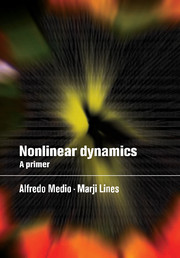Book contents
- Frontmatter
- Contents
- Preface
- 1 Statics and dynamics: some elementary concepts
- 2 Review of linear systems
- 3 Stability of fixed points
- 4 Invariant and attracting sets, periodic and quasiperiodic orbits
- 5 Local bifurcations
- 6 Chaotic sets and chaotic attractors
- 7 Characteristic exponents, fractals, homoclinic orbits
- 8 Transition to chaos
- 9 The ergodic approach
- 10 Deterministic systems and stochastic processes
- Further reading
- Bibliography
- Subject index
Preface
Published online by Cambridge University Press: 14 May 2010
- Frontmatter
- Contents
- Preface
- 1 Statics and dynamics: some elementary concepts
- 2 Review of linear systems
- 3 Stability of fixed points
- 4 Invariant and attracting sets, periodic and quasiperiodic orbits
- 5 Local bifurcations
- 6 Chaotic sets and chaotic attractors
- 7 Characteristic exponents, fractals, homoclinic orbits
- 8 Transition to chaos
- 9 The ergodic approach
- 10 Deterministic systems and stochastic processes
- Further reading
- Bibliography
- Subject index
Summary
Over the years we have had the rare opportunity to teach small classes of intelligent and strongly motivated economics students who found nonlinear dynamics inspiring and wanted to know more. This book began as an attempt to organise our own ideas on the subject and give the students a fairly comprehensive but reasonably short introduction to the relevant theory. Cambridge University Press thought that the results of our efforts might have a more general audience.
The theory of nonlinear dynamical systems is technically difficult and includes complementary ideas and methods from many different fields of mathematics. Moreover, as is often the case for a relatively new and fast growing area of research, coordination between the different parts of the theory is still incomplete, in spite of several excellent monographs on the subject. Certain books focus on the geometrical or topological aspects of dynamical systems, others emphasise their ergodic or probabilistic properties. Even a cursory perusal of some of these books will show very significant differences not only in the choice of content, but also in the characterisations of some fundamental concepts. (This is notoriously the case for the concept of attractor.)
For all these reasons, any introduction to this beautiful and intellectually challenging subject encounters substantial difficulties, especially for non-mathematicians, as are the authors and the intended readers of this book. We shall be satisfied if the book were to serve as an access to the basic concepts of nonlinear dynamics and thereby stimulate interest on the part of students and researchers, in the physical as well as the social sciences, with a basic mathematical background and a good deal of intellectual curiosity.
- Type
- Chapter
- Information
- Nonlinear DynamicsA Primer, pp. xi - xivPublisher: Cambridge University PressPrint publication year: 2001

